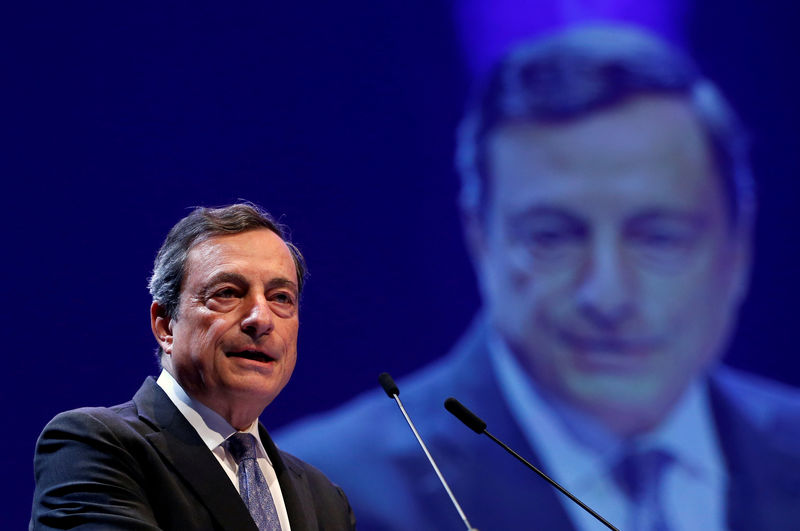 © Reuters. ECB expected to hold on rates and provide tapering details
© Reuters. ECB expected to hold on rates and provide tapering detailsInvesting.com – The European Central Bank is widely expected to stand pat on when it announces its monetary policy decision at 7:45AM ET (11:45GMT) Thursday, with markets concentrating on plans for winding down, or tapering, its asset purchase program which is currently set to expire in December.
Most of the focus will be on 45 minutes after the announcement, as investors look for further details on when and how the central bank could start unwinding its monthly quantitative easing program.
Draghi indicated last July that discussions regarding a change in monetary policy stance will begin in the fall and promised in September that the bulk of the decisions regarding the asset purchase program are likely to be made in October.
The ECB has the necessary ingredients to start moving ahead with policy accommodation as the euro zone economy is performing well, there are some indications that inflation pressure is beginning to build and credit conditions are showing improvement.
Markets look for details on tapering amount and extension
Market experts believe the ECB will announce that it will ($47 billion) from the current €60 billion ($70.6 billion) beginning in January. They were mostly split on whether the program would last six or nine more months after that.
Sources close to the ECB’s pre-meeting discussions say a nine-month extension seems likely with debate over monthly volumes between €25 billion and €40 billion ($29.4 billion to $47 billion) a month.
The two most persistent views among analysts seem to be a coin toss between a six-month extension of €40 billion or a nine-month one at a lower €30 billion ($35.3 billion), both resulting in a similar total increase to the purchase program, although some experts have also suggested a 12-month extension at around €25 billion a month.
But the real issue will be whether to keep the asset buys open ended, making another extension possible, or signal an eventual end of bond purchases, as demanded by hawks, including powerhouse Germany.
The focus will be on Draghi’s introductory statement with particular attention to the wording back in September that “we confirm that our net asset purchases, at the current monthly pace of €60 billion, are intended to run until the end of December 2017, or beyond, if necessary”.
Experts agree that both the amount and the end date will change, but there is some debate over whether the ECB will opt to keep the “or beyond, if necessary” in order to maintain wiggle room.
Timing details may bring forward market expectations for 1st hike
Removing that portion of the statement would imply a fixed end to the asset program, implying a more hawkish stance, with the capacity to bring forward market expectations for the first rate hike.
Markets are pricing in a first hike of 10 basis points to the during the first quarter of 2019. This rate defines the interest banks receive for depositing money with the central bank overnight and, currently at -0.40%, has been negative since June 2014.
Odds for the timing of rate hikes may be adjusted in the case that the ECB decides to place a specific end date to its quantitative easing program (QE) instead of leaving the door open to additional purchases.
Risk to the euro
As Credit Agricole (PA:) indicated in a recent note to clients, “Parallels with December 2016 – the last time around when the (ECB) Governing Council extended its QE program and sent the euro tumbling – seem inevitable.”
“That said we note the differences, which could help the euro regain ground after the ECB meeting,” they said.
They noted that euro zone fundamentals and FX valuations are “still quite favorable” and concluded that “we believe that the longer-term risks for the currency are still to the upside”.
Credit Agricole repeated its call for long positions in and .
Some strategists point to the fact that the ECB’s announcement for tapering will mark a move away from its dovish stance when compared to the last policy meeting and highlight that the euro-dollar has already fallen 2% since then.
In that light, some analysts suggested that the near-term reaction in the euro could actually be to the upside.
Experts at Fullerton Markets pointed this week to the fact that the rebounded since early last month.
“One of the main reasons was (that) ECB president Mario Draghi showed no rush to tighten monetary policy,” they explained, but noted that many traders took profit on their EUR/USD long positions when the pair reached the key level of 1.20.
“However, risk of ‘ECB to tighten soon’ cannot be ignored this week. If that happens, dollar could end its recent uptrend as early as this week,” these strategists concluded.
Source: Investing.com



























